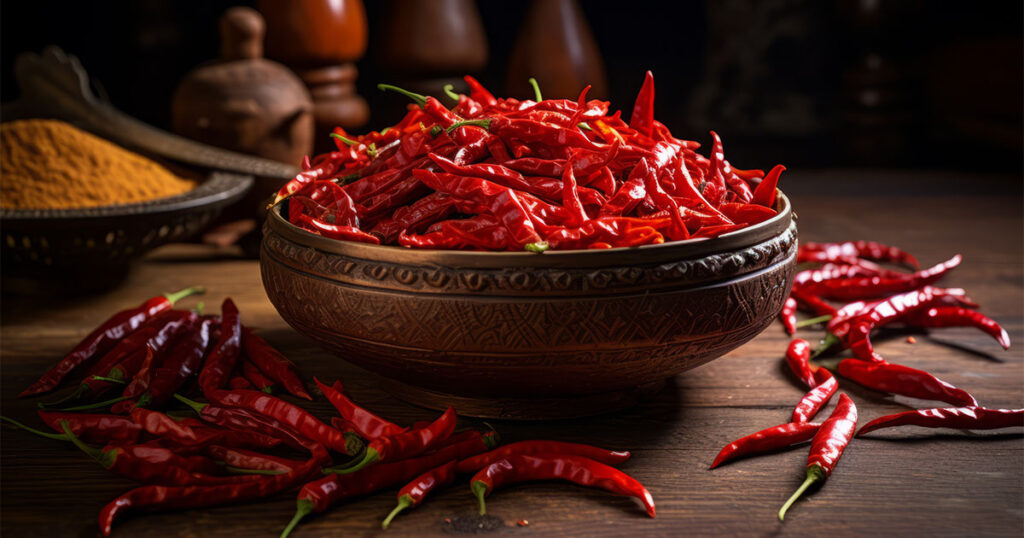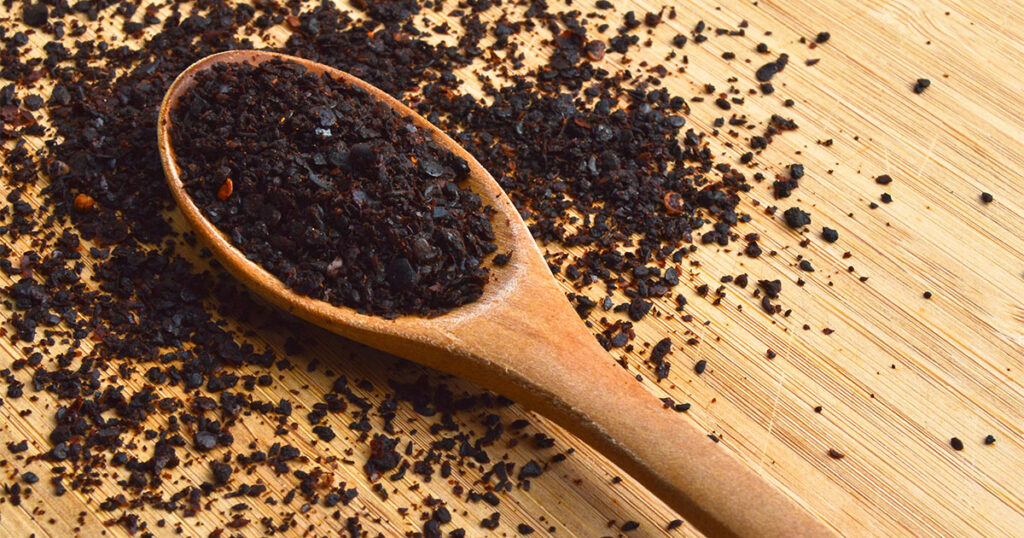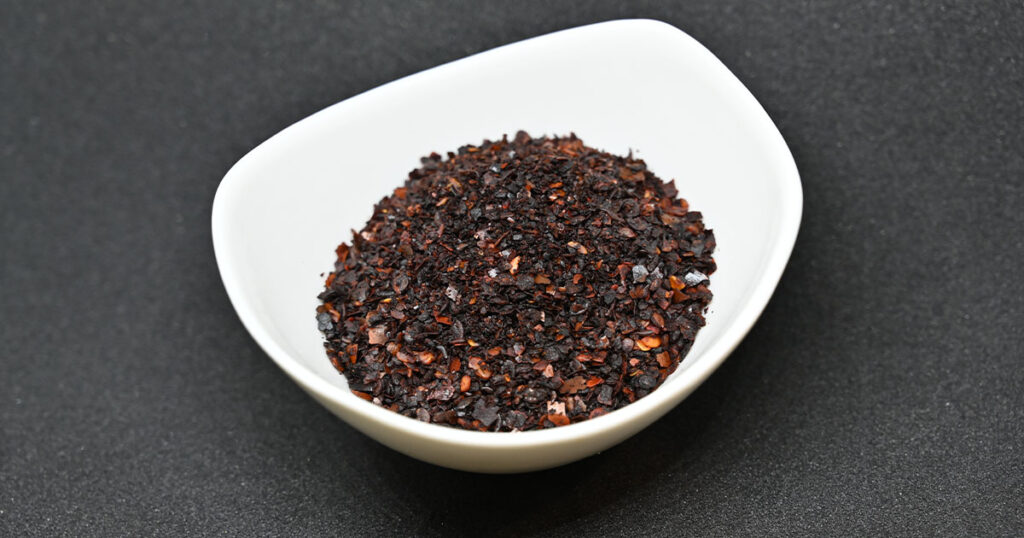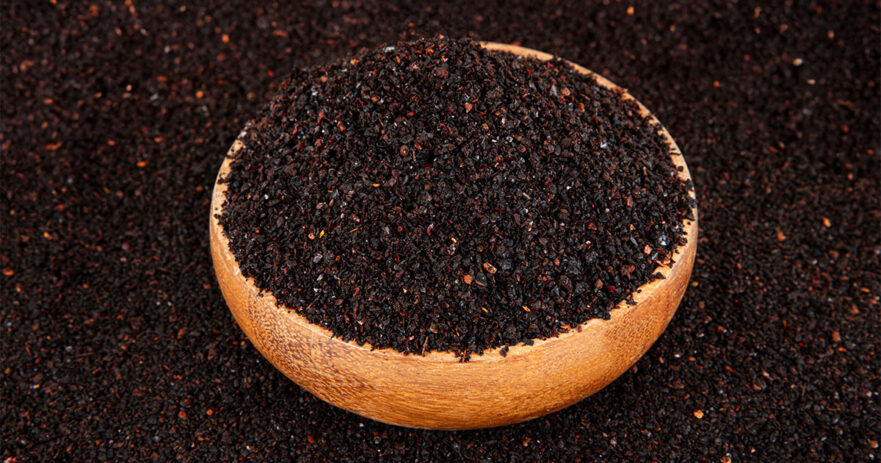In this article about Urfa biber pepper:
🗺️ Origin and history | 🌶️ Uses | ✨ Appearance and taste | 🧑🌾 Growing – gardening | 👨🍳 Cooking – recipes | 🛒 Where to buy | 🫙 How to store | 👨⚕️ Health benefits | 🌶️ Alternatives and substitutes | ❓ Frequently asked questions
What is Urfa biber pepper?
The Urfa biber, also known as Isot pepper, captivates the culinary world with its distinctively rich and smoky flavor profile. Originating from the vibrant landscapes of Turkey, particularly the Urfa region, this pepper distinguishes itself on the Scoville scale with a medium heat that gradually builds, offering a unique spicy experience.
It undergoes a traditional sun-drying process, followed by a night-time sweating method, contributing to its moist texture and deep, dark burgundy hue. With a Scoville Heat Unit (SHU) ranging from 30,000 to 50,000, Urfa biber strikes a balance between warmth and flavor.
Renowned for its smoky, earthy undertones, with hints of chocolate, raisin, and even tobacco, Urfa biber adds unparalleled complexity and rich flavor to dishes. The name “Urfa biber” reflects the pepper’s origin and the traditional techniques employed in its cultivation.
Are Urfa biber peppers spicy? How hot are they?
Urfa biber Scoville: 30,000 to 50,000 SHU
The Urfa biber, while not as notorious for its heat as some of the world’s spiciest peppers, occupies a unique position on the Scoville scale with a heat rating ranging from 30,000 to 50,000 SHU. This classifies it as a medium-hot pepper, providing a warmth that builds gradually, allowing for a spicy experience without overwhelming the senses.
For comparison, the jalapeño pepper generally scores between 2,500 to 8,000 SHU, highlighting the Urfa biber’s relatively higher heat level. Even the habanero pepper, known for its significant heat, has a Scoville rating between 100,000 and 350,000 SHU, placing the Urfa biber in a moderate position within the vast range of chili peppers.
The medium heat of the Urfa biber does not detract from its appeal; rather, it complements the pepper’s rich, complex flavor profile, making it a sought-after ingredient for those looking to add depth and unique warmth to their dishes without the extreme spiciness found in some of the world’s fiercest chilis. This balance between flavor and heat makes the Urfa biber versatile for culinary enthusiasts exploring spicy yet flavorful creations.
🗺️ ORIGIN AND HISTORY
Where does the Urfa biber pepper come from?
Originating from the historic city of Urfa in Turkey, the Urfa biber, also known as Isot pepper, is a distinguished member of the Capsicum annuum species. The Urfa region, with its rich soil and ideal climate conditions, plays a pivotal role in the pepper’s distinctive flavor profile, which includes smoky, earthy undertones enhanced by sun-drying and night-time sweating processes.
This pepper symbolizes Turkish culinary tradition, embodying centuries of agricultural heritage and artisanal crafting techniques. The Urfa biber’s deep, dark burgundy color and complex flavor profile, ranging from chocolate to raisin and tobacco, make it a standout ingredient in the world of spices. It has garnered appreciation in Turkey and internationally as chefs and food enthusiasts seek out its rich, smoky essence to elevate their dishes.
Its moderate heat level, coupled with its rich flavors, challenges and expands the palate, offering a culinary experience that is both unique and deeply rooted in Turkish culture. The Urfa biber tells a story of tradition, cultivation, and culinary innovation through its origin and history, making it a treasured spice among those who value depth and complexity in their cooking.
🌶️ USES
What are Urfa biber peppers good for? How to use them?
The Urfa biber, with its distinctive smoky and earthy flavor complemented by undertones of chocolate, raisin, and tobacco, is an incredibly versatile ingredient that can transform a wide range of dishes. Its medium heat and rich flavor profile make it an excellent addition to various cuisines, enhancing the taste and visual appeal of culinary creations.
One of the most common uses of Urfa biber is Urfa chili flakes, which can be sprinkled over meats, vegetables, or salads to add a deep, smoky flavor and a visually striking burgundy hue. These flakes are a staple in many kitchens, appreciated for their ability to impart a unique warmth and complexity without overpowering the dish.
Urfa biber is also fantastic when integrated into sauces, marinades, and rubs, where its moist texture and robust flavor can deeply penetrate and enhance the food. Its smoky notes make it an ideal match for grilled or roasted dishes, offering a subtle heat that builds with each bite.
In addition to savory dishes, Urfa biber’s subtle sweetness and richness open innovative dessert-making avenues. A sprinkle of Urfa chili flakes can elevate the complexity of chocolate desserts, ice creams, and even fruit salads, introducing a surprising and delicious contrast that delights the palate.
Moreover, Urfa biber is increasingly popular in vegetarian and vegan dishes, adding a meaty depth and smokiness that can sometimes be missing from plant-based meals. Urfa biber ensures every dish is imbued with its characteristic warmth and flavor, whether stirring into stews, soups, or lentil dishes.
The rich, smoky essence of Urfa biber and its gradual, lingering heat make it an invaluable spice for culinary enthusiasts looking to explore spicy yet flavorful creations. Its versatility and unique flavor profile have solidified its place in traditional Turkish cuisine and modern international dishes, making it a treasured ingredient for those seeking to add depth and complexity to their cooking.
✨ APPEARANCE AND TASTE

What does an Urfa biber pepper look like?
The Urfa biber, predominantly found in the form of flakes rather than fresh peppers, is renowned for its visually appealing deep, dark burgundy hue, resulting from its unique sun-drying and night-time sweating processes. Unlike many other chili peppers that present a bright red or green color, Urfa biber matures into a shade that verges on black, offering a rich visual appeal that is as unique as its flavor profile. The peppers themselves are of moderate size and, once dried and crushed into flakes, exhibit a moist and oily texture, unlike the typical dryness of other chili flakes. This distinct appearance and texture make Urfa biber a standout addition to any dish, not only for its flavor but also for its aesthetic contribution.
What does Urfa biber pepper taste like?
The flavor of Urfa biber is as distinctive as its appearance, characterized by a complex and layered taste profile. Urfa biber boasts smoky and earthy undertones, beautifully complemented by hints of chocolate, raisin, and a subtle note of tobacco. This rich and deep flavor, paired with a medium heat that builds gradually, makes it a versatile spice that adds warmth and depth to dishes without overwhelming them. The smokiness is particularly notable, derived from the traditional drying process, which imparts a unique aroma and taste that is highly sought after in culinary circles. Urfa chili flakes can transform a simple dish into a complex culinary experience, enhancing the flavor profile with their distinctive smoky sweetness and lingering warmth.
🧑🌾 GROWING – GARDENING
How to grow Urfa biber peppers?
Urfa biber peppers thrive best in conditions that mimic their native Urfa environment in Turkey. They require a warm climate and ample sunlight to foster their distinctive deep, dark burgundy hue. Well-drained soil is essential to avoid root rot, ensuring healthy pepper development. Regular watering is critical, maintaining the soil’s moisture without oversaturating, which mirrors the balance of dry and moist conditions experienced by these peppers in their traditional cultivation methods. Adding organic compost or fertilizers can enrich the soil with nutrients, promoting robust plant growth and pepper production.v
When to pick Urfa biber peppers?
Harvesting Urfa biber peppers at the correct time is vital for capturing their characteristic flavor and heat. With a maturation period of around 70-90 days, these peppers are typically ready for harvest when they exhibit their signature deep burgundy color and skin wrinkles. This ripening usually happens later in the growing season, allowing the peppers to develop their rich, complex taste profile fully. Monitoring for the change in color and texture will guide the optimal harvesting time, ensuring the peppers have the ideal moisture content and flavor concentration for processing into flakes or using whole.v
👨🍳 COOKING – RECIPES

Cooking / Recipe ideas for Urfa biber
The Urfa biber, with its smoky, earthy undertones and hints of chocolate, raisin, and tobacco, offers a versatile flavor that enhances various dishes. Its medium heat and complex taste profile make it an excellent choice for culinary experiments, ranging from savory to sweet creations.
For savory dishes, Urfa biber can be used to marinate meats such as lamb, beef, and chicken, adding a rich depth and warmth. Its smoky essence pairs well with grilled vegetables, stews, and soups, providing a subtle heat and aromatic flavor. A popular Turkish dish featuring Urfa biber is lahmacun, a flatbread topped with minced meat, vegetables, and herbs, all seasoned with this distinctive spice.
Urfa biber brings a meaty depth to lentil stews, roasted cauliflower, and stuffed bell peppers in vegetarian and vegan recipes. It’s also an excellent spice for enhancing the flavors of bean salads, hummus, and dips, offering a unique twist to traditional recipes.
Urfa biber is also making its way into desserts, where its smoky sweetness can add an unexpected layer to chocolate-based desserts, brownies, and mousses. Sprinkling a little Urfa biber on vanilla ice cream or fruit salads can introduce a surprising and delightful contrast of flavors.
For those interested in exploring the richness of Urfa biber in baking, it can be incorporated into bread doughs or pastry fillings, creating baked goods that are both aromatic and flavorful.
Lastly, Urfa biber is a wonderful addition to cocktails and beverages. A pinch can add depth and a hint of spice to chocolate martinis, spiced ciders, or even Turkish coffee, giving a modern twist to traditional drinks.
🛒 WHERE TO BUY
Where can I buy Urfa biber peppers?
Urfa biber peppers, often sold as dried flakes due to their unique flavor profile and processing method, can be found at specialty spice shops, both physical and online. Retailers specializing in Middle Eastern or international cuisines are likely sources. Online platforms offer a convenient way to purchase Urfa biber flakes, with various suppliers catering to different preferences.
Where can I buy Urfa biber pepper plants?
Finding live Urfa biber plants outside Turkey can be challenging, but some specialized nurseries or online gardening stores might offer them, especially those focusing on exotic or international plant varieties. These might be available seasonally, so checking availability in spring and early summer is advisable.
Where can I buy Urfa biber pepper seeds?
Urfa biber seeds are available through online seed stores and might be found at gardening shops that offer a wide range of chili pepper seeds. Websites offer Urfa Biber pepper seeds for those interested in growing these peppers from scratch. The seeds can be planted in well-draining soil and require warm, sunny conditions for optimal growth, mimicking their native environment in Urfa, Turkey.
🫙 HOW TO STORE
How do I store Urfa biber pepper?
Urfa biber peppers, known for their unique smoky and slightly fruity flavor profile, are almost exclusively sold in their dried and crushed form due to the specific processing they undergo. To maintain their distinct moist and oily consistency, which sets them apart from other dried chili flakes, store Urfa biber in a cool, dry place away from direct sunlight. An airtight container is ideal for preserving their flavor and preventing the absorption of moisture or odors from the environment. This storage method helps retain the pepper’s rich taste and aroma.
Can Urfa biber peppers be frozen?
Given Urfa biber peppers are typically available in dried form, freezing is unnecessary or not recommended, as their processing already ensures a long shelf life when stored properly. These peppers’ unique drying and “sweating” process preserves their natural oils and moisture, contributing to their distinctive chewy texture and rich flavor profile, which would not benefit from freezing. Instead, adhering to proper dry storage practices will suffice to maintain their quality over time.
❤️🩹 HEALTH BENEFITS

Are Urfa biber peppers healthy?
Urfa biber peppers, known for their unique smoky and sweet flavor with a hint of raisin or chocolate, offer more than just culinary delight. These peppers are rich in capsaicin, a compound renowned for its anti-inflammatory and pain-relieving properties, which may also aid in boosting metabolism. Additionally, Urfa biber is a good source of antioxidants, which are crucial in protecting the body from damage caused by free radicals. Vitamin C in Urfa biber may boost the immune system and help protect the body against infections.
Including Urfa biber in your diet may provide these benefits, but as with all spicy foods, it should be consumed in moderation to avoid gastrointestinal discomfort, especially for those sensitive to capsaicin or with a history of digestive issues.
For those looking to explore the rich flavors and health benefits of Urfa biber, incorporating this spice into your cooking can be a delightful way to enjoy its complex taste while benefiting from its nutritional properties.
🔄 ALTERNATIVES AND SUBSTITUTES
What’s a suitable alternative to Urfa biber pepper?
Finding a suitable alternative for Urfa biber pepper involves looking for spices with similar complexity and heat levels. Urfa biber is known for its smoky, earthy flavor with hints of chocolate, tobacco, raisin, and coffee, combined with a mild to moderate heat level of around 30,000 to 50,000 Scoville heat units (SHU).
Aleppo pepper is a close relative and a good substitute, offering a similar flavor profile with a bit less heat, approximately 10,000 SHU. It shares a similar fruity and subtly sweet flavor due to the comparable soil and climate conditions in which it is grown near the Urfa region. The mild flavor of Urfa biber also draws comparisons to the Mexican ancho chile, which is earthier with some chocolate and coffee notes, albeit less smoky than Urfa biber.
For cooking applications, both Aleppo and ancho chiles can serve as suitable substitutes in dishes where Urfa biber is called for. The amount used can be adjusted based on the desired level of heat and smokiness. These alternatives can be used in a variety of culinary contexts, from savory meats and vegetables to enhancing the flavors of chocolate-based desserts and other sweet treats.
How do you pronounce Urfa biber peppers?
The Urfa biber peppers are pronounced as “OOR-fah BEE-ber PEH-perz“.
🙋 FREQUENTLY ASKED QUESTIONS
FAQ about urfa biber peppers
How hot is Urfa biber pepper?
Urfa biber, or Isot pepper, offers a unique spicy experience that differentiates it from other chili peppers. Its heat level on the Scoville scale ranges from 30,000 to 50,000 Scoville Heat Units (SHU), classifying it as a medium-hot pepper. Unlike other peppers, where the heat hits immediately, Urfa biber's warmth builds gradually, providing a rich, smoky, and complex flavor profile without overwhelming the palate. This gradual increase in heat allows for a more nuanced culinary use, making it a versatile ingredient in both savory and sweet dishes. Its distinctive processing, sun-drying followed by a night-time sweating method, contributes to its moist texture and deep, dark burgundy hue, enhancing its unique taste. Urfa biber's moderate heat level and rich flavors make it an excellent choice for those looking to add depth and warmth to their dishes without the extreme spiciness in some of the world's fiery chilis.
What’s the difference between Urfa biber and Aleppo pepper?
Urfa biber and Aleppo pepper are celebrated Middle Eastern spices but differ significantly in flavor, heat level, and processing. Urfa biber, originating from Turkey, is known for its smoky, earthy flavors with chocolate, tobacco, and raisin notes. It undergoes a distinctive process that includes sun drying and night sweating, contributing to its moist texture and deep, dark color. Its heat builds gradually, ranking between 30,000 to 50,000 SHU on the Scoville scale.
On the other hand, Aleppo pepper hails from Syria and presents a milder heat level, typically around 10,000 SHU, making it less spicy than Urfa biber. It boasts a bright red hue, slightly fruity taste, and moderate spiciness with cumin-like undertones, offering a different kind of complexity to dishes.
While both peppers enhance the flavors of various dishes, their distinct characteristics and heat levels offer unique culinary experiences. Urfa biber's smoky depth and gradual heat suit rich, hearty dishes and even some desserts. In contrast, Aleppo pepper's fruity tang and milder heat suit lighter fare, such as salads, meats, and traditional Middle Eastern dishes.
